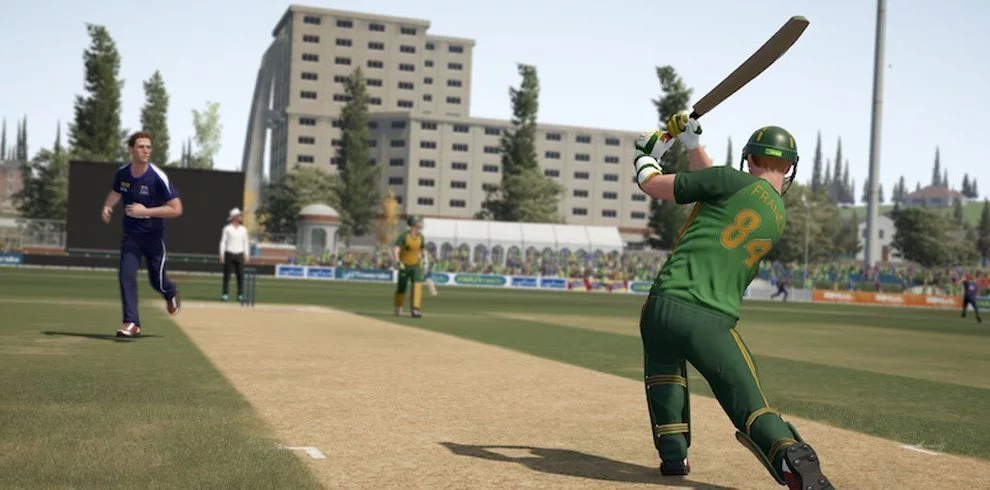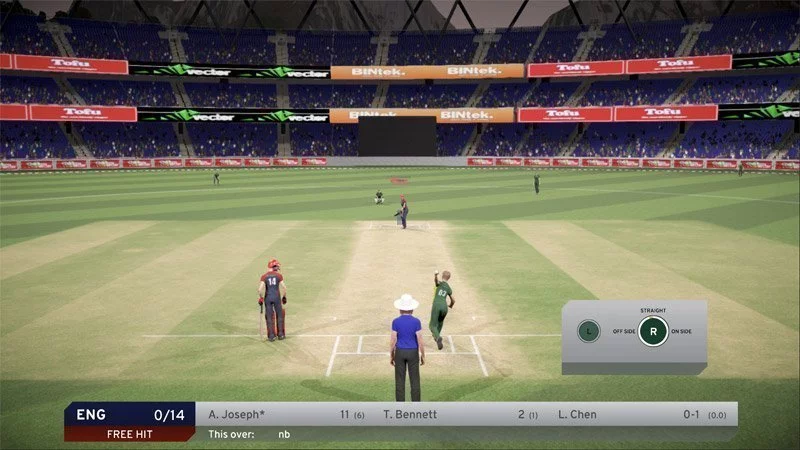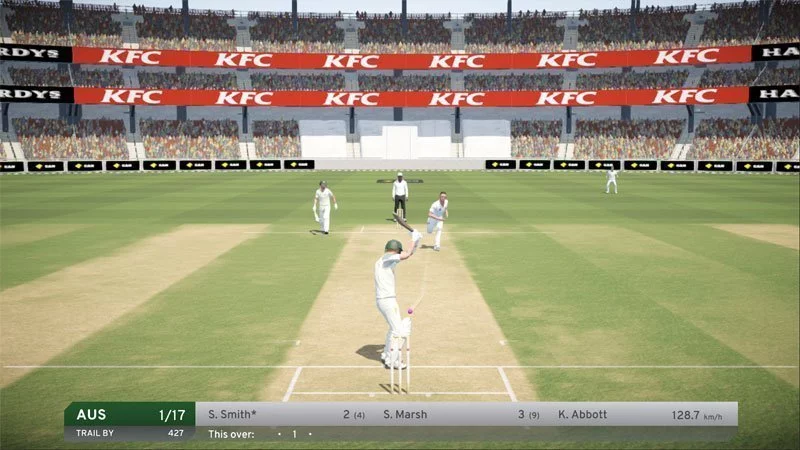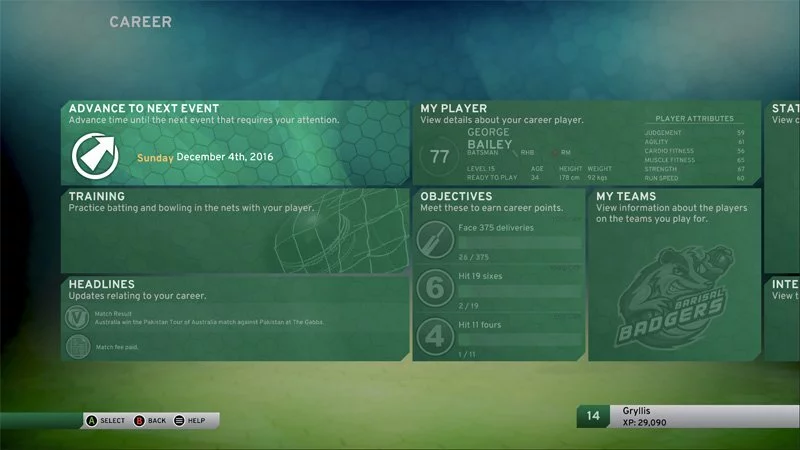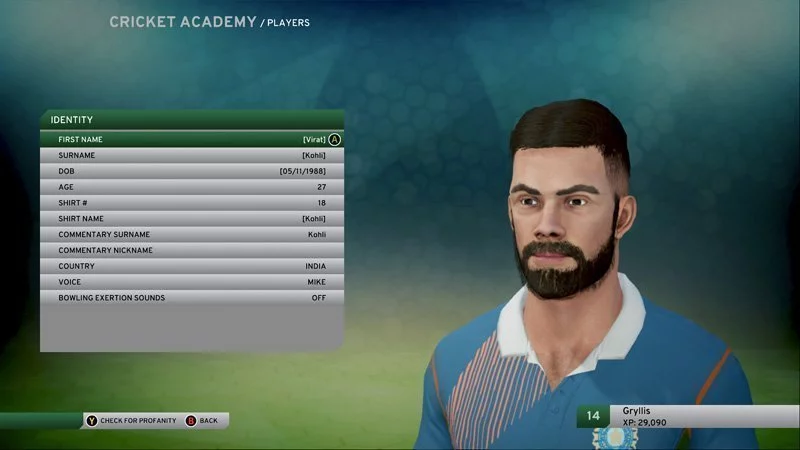Don Bradman Cricket 17 builds upon its impressive debut last-generation with a greater emphasis on a deeper career mode, and a wider sandbox to customise all things cricket. Despite being one of the world’s most popular sports, game duties have fallen to a small studio in Melbourne; and while the lack of polish attributed to EA Sports’ juggernaut is well apparent, it’s countered by an unprecedented suite of customisation options, ultimately leaving the true depth of Don Bradman Cricket 17 in the hands of its community.
Cricket 17 improves across the board; batting remains largely unchanged, but benefits from minor refinements that make movements more elegant. Bowling now differentiates between full and yorker length deliveries, and adds more tricks to the arsenal of both pace and spin bowlers. Field catches are mostly automated, and much less robotic, while those behind the wicket and impressive run-saving dives are controlled by a tastefully infrequent slow-motion mini-game. Best of all, now you can customise, share and download just about anything, from a world-class player to an advertising board at the MCG or a specific type of bat. While most of society is floundering around lost in shopping malls and online checkouts desperately seeking Christmas presents, I’m lost in the intricate creation tools of DBC17 tweaking every minor detail. The generic teams and players on-disc should all be able to be replaced with the press of a single button, by selecting “replace all with best”, but this isn’t available prior to launch to test. However, I was able to manually replace individual teams, and the quality is impressive.
If I’m honest, I’m really awaiting the most dedicated members of the community to create more players, teams and stadia, because based on those already available to download, they clearly have more patience and talent than I. While clearly a visual improvement being developed as PS4 and Xbox One game, these players haven’t had their faces scanned, and that’s the clear divide between big and small budget sport games; yet some of them are remarkably accurate, all created by users. I haven’t watched enough international women’s cricket to pick out many familiar faces, but the generic female squads can all be replaced, so long as the community makes them. However, I have watched a lot of the WBBL this season, and DBC17 does a commendable job in replicating the tactics of the women’s game, and not merely putting a skin over the male players. The subtle differences in body shape and movement between the boys and girls stands out, as does their style of play. The female pace bowlers use less brute speed but more flight and bounce, as they tend to do in the WBBL. I found it quite challenging having to relearn timing, switching between the medium-fast speeds spanning 125-155 km/h in the men’s competition to speeds regularly in the 90s with a lot more variation in the women’s. The skills are the same, yet it feels very different to play. I had worried the inclusion of female players might be a token effort to bestow praise on the back of the box, but it’s much more than that. They’ve genuinely been included with as much attention to detail to the attributes specific to women’s cricket (at least T20 cricket, because I’m not familiar enough to comment on other forms) as the men.
Even as a returning player, it takes time to learn the craft of batting and bowling, and much longer to notch a classy century or five wicket haul. Remembering the relatively initiative, yet complicated, controls is no simple feat, but cricket is no simple game. It’s inherently frustrating to see my burgeoning career junior stumble off the pitch with another single digit score, but it’s the intense level of mental concentration that makes the real-world tussles so exciting. I can smack balls out of the park as a level 90 David Warner, but as a level 30 newcomer, I need to learn to play within myself, even against lower quality opposition.
Bowling has seen a general overhaul with a remodelled, but not entirely new control scheme. Ball in hand, the left control stick is used to select the type of delivery, while the face buttons are used to indicate a short, good, full and now yorker length delivery, and trigger the bowler’s approach. As he or she moves toward the crease, two timing meters need to be hit for pace by first pulling back the right stick, and then flinging it forward determining the ball’s trajectory. There are modifiers for effort and slower balls, and it seems a little easier to find a nagging line and length – but there’s still no pitch marker, and the coloured indicators can be switched off, to give a greater challenge as a batsman. Spin bowlers have had more work done to their routines, with pre-bowl options expanded to include flight and bounce, alongside spin. You’ll still need to rotate the left stick before releasing the ball with the right, but only marginally, and the indicator is now much clearer. In short, it’s considerably easier to pick up the art of spin bowling.
The Don Bradman series has exclusive rights to proclaim it makes bowling enjoyable and nuanced — it’s where most cricket games fail. It feels like you’re putting a plan into action when bowling in the right areas, especially against impatient human opponents who are easy to set up with a well timed slower ball. But it enviably grows stale attempting to bowl an entire first class innings, or even a one day match. That’s resolved by an array of options to simulate all or parts of an innings. You never have to bowl, or field as a career player, if you don’t want to; or skip to the next wicket or a particular session of play. Likewise, the ability to simulate while batting at the non-striker’s end returns, and this time your partner doesn’t block out entire overs in tight T20 run chases.
The foundation of batting remains unchanged. It’s reliant on precise shot selection, correct footwork, lightning fast reflexes and impeccable timing. Perhaps it’s because I’ve spent so many hours out in the middle in DBC14, but like a batsman in form, I feel like I’ve got more time to consider and play shots in DBC17. The combination of using the left stick to select front or back foot and the right stick to direct the shot still happens within a second, but I’ve barely premeditated a single stroke. Watching someone else play, 150km/h thunderbolts appear a little slow, but with the controller, I’m relishing that extra split-second to make an appropriate choice – it’s largely because the length indicator appears around the ball just before the bowler releases it, like a real world batsman having some idea of what’s heading his way by watching a bowler’s hand. Turn off the indictors, and decision-making feels alarming rushed, at least while getting my eye in.
The craft of batting is more complete in DBC17. There’s more flexibility to move about in the crease, which never really worked in DBC14, and charging the bowler is now much more effective at changing the length of a delivery, when played to the right balls. Ground shots are also much more useful, and balanced better in the risk-versus-reward scenario against aggressive slogs, which were too easy to execute once you mastered the controls last time around. There’s also a new precise shot modifier, using soft-hands to mitigate edges and take the pace off the ball to nudge it into gaps and run quick singles, which the superhuman fielders of DBC14 didn’t allow. It’s all brought together by a handy optional indicator, which ranks footwork, timing and shot selection on a red, yellow or green scale after each ball. Like the rotating Channel Nine stats, it’s seamlessly integrated into the HUD, so never looks out of place, and is an extremely useful stat suited to the virtual form of cricket. It’s all well and good recreating actual stats and graphs, and DBC17 does a solid job of that, but integrating ball-by-ball information about an element specific to video game cricket is far more advantageous.
The new menu system, following the tile conventions of most annual sports games, puts the enhanced career mode front and centre, alongside online play. It’s the focal point of Don Bradman Cricket 17, by virtue of the sport’s rare fascination with individual accomplishments amongst a team performance. Playing as a single man, or woman, amongst the XI is much enticing in cricket, compared to similar modes in football and basketball. But for those who prefer to control the entire team, DBC17’s career mode now presents that as an option, along with individual batting and bowling difficulties, before the start of each match. While I haven’t found it yet, inevitably there will be a weaknesses to exploit in batting. The A.I. is more attune to valid field adjustments, but as you improve, eventually you’ll start smacking balls for 6 with too much ease. While first class matches are inherently harder than club cricket, the option to change the difficulty before each career match is a welcome one, to ensure you’re always being challenged — as much as it’s fun for a game or two, cricket quickly becomes boring if there isn’t a contest between bat and ball. There’s also an option to change the difficulty of selection status, if you want to play against tough opponents but be picked for higher class teams without much delay. Setting to easy it like having your dad pick them under 12s team.
Choose to start as either an established player, like Steve Smith already in the Australian Test team, or an 18-year-old rookie. The latter mode sends you to club cricket, entirely T20 matches, where you’ll need to earn your stripes before being called into the state and finally national team at T20, ODI and Test level. Perform well enough, and contracts from lucrative international T20 competitions will be forthcoming, on your way to eventually being named national captain.
The career screen has a lot more information than DBC14, but strangely omits a key feature: your player’s stats. There’s an entire section dedicated to the statistics of all competitions around the world, most having nothing to do with your rising star, but nowhere to view your own performances, outside the brief window when they pop-up during a match. It’s an odd oversight for a game, and sport, so obsessed with numbers, especially since those stats are all viewable in the cricket academy for thousands of other players, but not your career journey.
In trying to forge a more dynamic career, DBC17 will annoy long-term players for the opposite reason of its predecessor. Whereas DBC14 left you stuck playing as part of the same teams for your entire career, DBC17 tries to rotate the squads, but is as successful as John Howard’s right arm leggies. I can see the playing XI is being picked automatically by choosing the best five batsmen, one all-rounder, a wicketkeeper, three pace bowlers and a spinner from the squad of 30. But that means the default Test, ODI and T20 teams you can set in the cricket academy are useless. Based on the current “best” community made Australian team — which I used to replace the on-disc imitation squad — Adam Voges bats at five in all three formats, and James Faulkner is a Test number 6. It’s disheartening to spend hours crafting squads, only to find it’s irrelevant in career matches, and that there’s no differentiating between teams for the three forms of the game. Whereas DBC14 left you stranded with the same Test, ODI and T20 teammates, DBC17 occasionally rotates the players, but has some of them play in the wrong formats and positions — Steve Smith batting at 3 in a Test? That’s crazy.
As a current-day star player, rather than a rookie, those squads are even more useless, because some custom players are replaced by the original generic ones — the players the cunning cricket academy system suggests you replace. I assume this is to keep the squads dynamic, but why are nobodies replacing Josh Hazlewood and Peter Nevill immediately? As soon as I started a career as Smith, a quarter of the Australian squad was replaced by no-names, several made the team, and a ponytailed pretty boy immediately took over the captaincy; that’s just not cricket, and undoes some of the brilliance of the customisation system. These squad bungles can and probably will be easily resolved, but it’s strange they exist in the first place. This is a game that allows unparalleled personal customisation of almost anything, and positions the career offering as its flagship mode, but the two are at odds when combined. In its present state, if you’re only going to play the career mode, it’s pointless spending much time tinkering in the creation suite; and any changes made after commencing a career, like downloading a new stadium or adding a new team, aren’t implemented in existing saves, forcing a restart if they really matter.
How it integrates with each mode aside, the DBC17 cricket academy creation options are truly extraordinary, pending there’s a dedicated community willing to do what licensing restrictions preclude. Big Ant introduced it out of necessity, as nobody wants to play as Martin Samson instead of Mitchell Starc, and has taken it to the extreme in DBC17. As much as playing at Adelaide Gardens was good enough, playing on a quasi representation of the redeveloped Adelaide Oval, complete with KFC and Qantas logos adorning the advertising boards, is more captivating. A lot of the best community content is already in the game, thanks to the academy being operational on PC and cross-platform sharing, but there’s still work to be done – and thank you to those who take the time to improve DBC17 for everyone else.
DBC14 launched with some seriously irritating glitches that overshadowed its triumphs during the opening months. DBC17 certainly isn’t immune, but doesn’t suffer from any of the same crippling gameplay disasters (at least, I haven’t been run out from a batsman standing outside his crease yet). The early bugs are more cosmetic than anything, aside from the Australian Captain rewriting the concept of standing outside of the crease. There’s also the odd frame rate drop and complete slowdown, which totally displaces batting timing. This is less frequent than in DBC14, but the greatest indictor DBC17 is running on enhanced, but otherwise much the same tech. The soundtrack is irritatingly familiar and the commentary is rubbish, but at least it’s been re-recorded by Mike Howard and former England batsman James Taylor. They have some new clunky quips and are sometimes accurate, but whatever is going on behind the scenes to compile the sound bites doesn’t work properly. Every time my career player comes out to bat, they mention he’s on debut, when he clearly isn’t, and I’ve had DRS reviews where they claim it’ll be easily overturned, when that doesn’t match what I’m seeing on-screen. I recommend muting the commentary, turning up the satisfying bat-on-ball sound effects, and putting on some background music; or better, commentary of some actual cricket.
The DRS imitation works well, considering the concept is at odds with the mantra of a video game; umpires are programmed to make wrong decisions, or to be something like a real human being, in other words. This gives you a chance to rectify their blatant mistakes, in a nod to the real life process of dismals. I tended to ignore it in DBC14, even when controlling Shane Watson, but have had more opportunity to spend challenges wisely in DBC17. Early in a career I was given out for a plumb LBW, when I was sure I had heard and felt the tiny controller vibration of a small inside-edge. Sure enough, the deflection was clear on replay with Snicko (or edge-o, in keeping with the lack of licensing), and the decision was overturned. Moments like that flirt with frustration – imagine if my team didn’t have a challenge remaining – but are deeply satisfying in their accurate portrayal of the regular shambles that is the broadcast of modern day cricket.
Outside of career, there are options to play complete tours, like Australia’s upcoming trip to India, or single competitions, like the IPL. As with everything else in DBC17, these are fully customisable to mitigate the lack of licenses. Here downloaded squads work perfectly, because you have complete control of the line-ups. These, and casual games, can be played locally by up to four players, with two on each team; if your teammate is anything like mine, prepare yourself for run-out debacles that would make Inzamam-ul-Haq smile. Short local matches, either Five5 or Ten10 games, are blisteringly fun in local co-op play, whereas full Test matches are better suited to a small group of dedicated players online. We haven’t been able to test online play pre-release, but don’t foresee any issues.
Don Bradman Cricket 17 expands on its pioneering predecessor with the fundamentals of cricket translating to fun, challenging gameplay. Batting and bowling are similar, but better rounded, and the introduction of female cricketers has been given the utmost care. The career mode is much deeper, and the customisation options are off the chart — it’s a cricket game that gives you back what you put in. There are some issues with bugs and glitches, but not as many that originally plagued DBC14, and the squad customisation options being ruthlessly undone by career mode will disappointment the most diligent fans. Don Bradman Cricket 17 delivers where it counts, with the strongest batting and bowling not only of the series, but of any cricket game. Now the rest is up to the community.
 |
|
The good
|
The bad
|
Don Bradman Cricket 17 was played on Xbox One using a digital code provided by the publisher. Click here to learn more about Stevivor’s scoring scale.
This article may contain affiliate links, meaning we could earn a small commission if you click-through and make a purchase. Stevivor is an independent outlet and our journalism is in no way influenced by any advertiser or commercial initiative.























